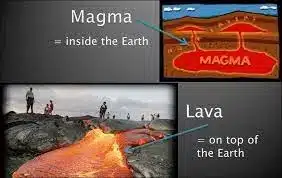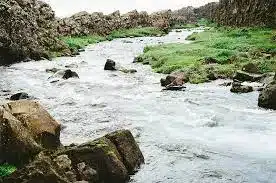Magma is a burning hot liquid and semi-liquid rock situated under Earth’s surface while lava is the magma that erupts out of a volcano vent onto the surface of the Earth.
Difference Between Magma and Lava
| Magma | Lava |
| The molten rock that is present beneath the surface of the earth is termed as Magma. | The molten liquid that gets erupted out of the surface of the Earth is termed as Lava. Lava is also referred to as Liquid Magma. |
| The temperature of Magma is slightly hotter and ranges from 1300-2400 degrees Fahrenheit. | The temperature of Lava is slightly colder and ranges between 1300-2200 degrees Fahrenheit. |
| The word Magma has its origins from Ancient Greek. | The word Lava has its origins from the Italian Language. |
| Magma takes much longer time in cooling, as it is located underground which leads to the creation of gigantic crystals | Lava has the property of cooling much quicker than magma. This leads to lava sometimes crystallizing into a glass |

Similarities Between Magma and Lava
- Lava and magma are exactly the same molten rock, except for the fact that magma is underground and lava is the magma that erupts onto Earth’s surface.
- Therefore, their mineral composition is the same.
Facts about Magma
- Magma is composed of minerals.
- It contains dissolved gases like carbon dioxide, water vapour, and sulphur in small amounts.
- Magma remains in a liquid state due to high pressure and extreme temperature below the earth’s crust.
- Magma is classified into three main types such as basaltic, rhyolitic, and andesitic and each of these types has a distinct composition of minerals.
- Silicon dioxide is present in a considerable amount in all kinds of magma.
Facts about Lava
- The higher the amount of silica present in lava, the more is its viscosity (thickness).
- Lava is a mixture of silicate minerals like olivine, amphibole, quartz, mica, feldspar, and pyroxene.
- The composition as mentioned above shows the behavior of lava rather than its temperature during an eruption.
- Lava flow can be distinguished into three fundamental types – aa lava flow, pahoehoe lava flow, and blocky lava flow. The aa flow contains free lumps of pointed lava pieces, whereas pahoehoe flow is relatively smooth. On the other hand, blocky flow is more or less similar to a flow. But, it is comparatively more viscous.
Also refer,
- Difference between Scalars and Vectors
- Difference Between Ductility And Malleability
- Download the pdf of Important MCQs From the History Of Ancient India
- List Of Important Inscriptions In India








